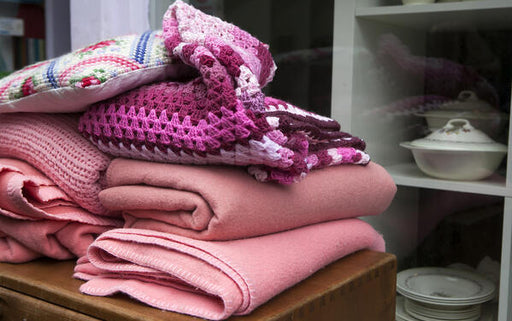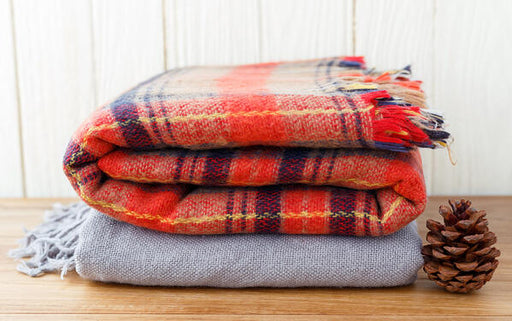Can I Wash A Wool Blanket?

Nothing says warmth and comfort like a cozy wool blanket. As the winter months creep in and days and nights get colder, you might find yourself using your wool blanket more often. Though wool is noticeably more durable than some other textiles and may not stain easily, it still needs to be cleaned once in a while. Learning how to care for and wash your favorite wool blankets can keep them around for years.
Here is what you need to know about washing, drying, and storing a wool blanket.
Can You Wash 100% Wool?
Yes, most of the time.
Know that, if you are going to be washing a 100% wool blanket, whether it is worn vintage or a harder weave, like Pendleton wool, you will have to be very gentle with it. Use only cold water and select a wool-friendly detergent, but more on that later.
The kind of wool used to make your cozy blanket determines how it will be washed. There are several kinds of all-natural wool used to make blankets, including:
- Alpaca: Versatile Alpaca wool is used in bedspreads, blankets, suits, and outerwear. Alpaca wool is popular for its durability and softness. Huacaya fleece is often used in blankets, whereas silkier Suri fleece is used in clothing.
- Angora: Not to be confused with mohair wool from Angora goats, this wool produced from Angora rabbits is fragile yet fluffy and feather-light. It has the best moisture-wicking of any wool or other natural fiber. Angora wool is often blended to make it stronger.
- Camel: One of the more economic choices, camel wool became popular in the 1920s and continues to be used in apparel, carpets, and upholstery. It is rare for blankets, but you may see some with a camel blend.
- Cashmere: Luxurious cashmere comes from cashmere goats and is difficult to produce. Although not as durable as sheep’s wool, cashmere is lightweight and extremely soft.
- Lambswool: Also called virgin wool, lambswool is sheared from young sheep. It is smooth, soft, wrinkle resistant, and hypoallergenic. Lambswool is more expensive, since a single sheep can only make lambswool once before maturing.
- Melton: One of the warmest, most durable wool types out there. Melton is thick, water-wicking, and wind-resistant, making it perfect for heavy wool blankets and outerwear.
- Merino: Largely used in sports apparel and winter blankets, Merino wool comes from Merino sheep that live in Spain, Australia, and New Zealand.
- Shetland: Cultivated from sheep native to the Shetland Islands of Scotland. This wool is used in knitting and is warm, lightweight, and versatile, but you rarely see it used in blankets.
You might be wondering, “What is the difference between cashmere and wool blankets?”
Cashmere is a very thin wool fiber, making it far less durable than some other types. That means that you must wash cashmere with the utmost care. Compared to thicker wool, cashmere also has less scaling, or microscopic ridges. That is why low quality wool and cashmere products are itchier, because the scales catch on skin.
Can I Wash a Pendleton Wool Blanket?
A Pendleton blanket is a little different than your typical wool blanket. Pendleton blankets have been crafted for over 140 years by Pendleton Woolen Mills of Oregon.
There are several styles of Pendleton wool blankets currently available, but all of them are made with either Merino wool or 100% virgin wool. In order to see whether you can wash your Pendleton wool blanket or not, read the washing instructions. Some can be machine washed or hand washed, while others have to be dry cleaned.
Can I Wash a Wool Blanket That Says Dry Clean Only?

You will notice that some of the wool blankets around your home will have a Dry Clean Only tag on them. In fact, you may have even routinely taken your Pendleton wool blanket to the dry cleaners out of fear the blanket would shrink or get ruined if you washed it yourself.
The truth is that it depends. Most wool blankets -yes, even cashmere- do not require dry cleaning. You just have to be careful.
Ultimately, if you are worried that something might go wrong, you can always take your Dry Clean Only items to the professional cleaners; if you’re willing to try another method, then keep reading.
How to Clean and Care For a Wool Blanket
Washing your wool blankets is not the only way to keep them clean and fresh. You can keep wool blankets for many years if you care for them correctly.
Here are some tips to consider:
- Air out your wool blankets. Ventilation is the best way to keep wool blankets fresh. Take your blankets outside and shake them out. Hang the blankets somewhere with air flow, as this will loose dirt and dust from the threads of the blanket. You can shake the blanket again before bringing it back inside.
- Use a soft-bristle brush. Lay the wool blanket on the floor and brush in the direction of the grain. The wool fibers will lay in the same direction, enhancing the look of the blanket. Furthermore, the bristles can help remove any stains or soil that were being held in the threading.
- Depilling. When the natural fibers of your wool blanket start coming loose, little balls-or pills-form. Wool clothes tend to pill. Pilling is the result of friction. In other words, the more you use your wool blanket, the more likely pills will form. You can get yourself a special de-pilling comb, also called a bobble remover, to untangle the fibers, leaving a smooth, soft surface behind.
You can do those three steps together or separately, depending on how much time you have.
But what about spot cleaning a wool blanket?
Obviously, simply airing out and brushing wool is not always going to remove small stains or make them less noticeable. Wool is naturally water-repellent, but that does not mean it is invincible against droplets of coffee or juice. As soon as you spill something on wool, you want to spot clean as soon as possible.

You will need three things: vinegar, a mild or pH-neutral laundry detergent, and a spray bottle. Then, follow the steps below.
- Make Your Cleaning Solution. In the spray bottle, mix together 1 part vinegar and 2 parts cold water. Do not use hot water, since that can shrink the fibers. Bonus: vinegar helps remove any musty odors.
- Treat the Stain. Spray the stained area and blot it gently with a clean washcloth. Spot test the blanket first to see if the dye comes off. If it does, you will need to follow the directions for having your wool blanket dry cleaned. If the vinegar and water solution is not effective, you can try mixing cold water with the pH-neutral detergent instead. Repeat the same process of spraying and blotting dry. The stain should gradually disappear.
- Dry the Area. Once the stain looks less noticeable, take a dry cloth to remove excess moisture from the wool. Then air out the blanket, letting it dry.
3 Ways To Wash a Wool Blanket

Now that you know how to care for a wool blanket and remove light stains, what about washing a wool blanket? By nature, wool is durable, soft, and warm. Damaging a wool blanket takes a bit of effort, making them easier to care for than some other materials. In fact, you do not even have to worry about washing them all that often. Most guidelines state that wool blankets need only be washed once every three months-and that is when you use them frequently.
There are three ways to clean a wool blanket. Let’s break down these methods:
-
Hand Washing Wool Blankets.
This is best for lambswool (virgin wool), as well as Merino and cashmere.
You will need a wool-friendly detergent (usually for delicates) and fabric softener. Alternatively, you can use a gentle shampoo, since wool is hair.
Hand washing wool is relatively straightforward. For most of the process, you let the water and detergent do their job. Begin by filling either your sink or the bathtub with tepid water (30ºC/80ºF or less). Add some of the wool detergent or shampoo to the water. Mix the detergent in well before adding your wool blanket. Submerge the material in the soapy water and let it soak for about 10-15 minutes.
After that time is up, gently swirl the wool blanket around the water. Seek out any trouble spots to rub lightly with your hand. Never rub the fabric together as you would with cotton or other products, as that friction will damage the wool fibers, resulting in bobbing and shrinking.
When you are finished washing the blanket, remove it from the dirty water. Rinse with clean water to remove any lingering soap.
-
Machine Washing Wool Blankets.
Take a look at your wool blanket to see if it allows for machine washing. Sturdier wool fibers, like lambswool or a Pendleton blanket, will do fine in the washing machine.
Keep in mind that most wool cannot be washed with a machine because the heated water and spinning will result in loss of shape, shrinking, and bobbing/pilling. Twill weave is less susceptible to damage. Never put softer wool, like cashmere, in the washing machine, even if your machine has a designated “wool wash.”
As with hand washing, you will need a non-toxic detergent for delicates or a mild shampoo. Select the cycle that uses cold or lukewarm water (30ºC/80ºF or less). If that is not available, select cold temperature and run on a gentle or delicate cycle. You want to avoid as much friction as possible during the spin cycle.
If your wool blanket has a stain, let a gentle soap sit on the stain for about 10 minutes prior to putting the blanket into the washing machine.
Does your washing machine have a hand wash cycle? You can also study that option if your machine is gentle enough.
-
Dry Cleaning Wool Blankets.
The safest method for washing wool materials is to have them dry cleaned. As mentioned earlier, it is up to you whether to try hand washing or machine washing your wool.
How to Keep Wool Blankets Soft

Wondering how to keep washed wool blankets soft?
The trick is in the detergent or shampoo you wash the wool textile with. You will find that most wool-friendly cleaning products contain oils, such as orange oil or lanolin. These are usually cruelty-free and eco-friendly as well, so you can feel good about the purchase.
Drying Wool Blankets
After you have completed one of the three above mentioned washing methods, you move onto the drying sequence. Never stick a wool blanket in a drying machine. Nor do you want to wring out the material and stretch it. Instead, you need to lay the wool flat to dry and gently press out the water.
You can also lay some dry towels down and place the wool blanket on top. Then roll the towels and blanket together like a burrito or Swiss roll to squeeze out any remaining moisture. Unroll the wool from the towels, reshaping if needed, and then lay it flat to air dry.
The gut reaction is to hang the blanket up like you are pitching a tent, but that is a no-no. This could cause sections of the blanket to lose shape and sag.
Never place the wool blanket directly in the sun, as that could bleach the colors.
Storing Wool Blankets
The best way to store a wool blanket is to wait until it has dried completely before folding it up. Then place it inside a breathable storage container, such as a cotton bag, and put it somewhere cool and dark. As with drying, you want to choose some place out of direct sunlight to prevent bleaching.
Always clean your wool blankets before storing them to prevent clothes moths. If you are worried about pests bothering your blankets in storage, you can always hang some clothes moth traps for peace of mind.
You can also use cedar shavings, since that will repel insects while adding a pleasant scent to any woolen clothing or bedding you have stored away.
Have a musty smell? Use some white vinegar.
Final Thoughts on Washing Wool Blankets

Now you know the answer to the question “Can I wash a wool blanket?” The answer is absolutely. Wool needs a bit of TLC when it is being hand or machine washed, but as long as you go slow and use mild detergents, your wool blankets will come out smelling fresh and feeling soft.
Check out more tips for caring for wool clothes and learn even more about how to wash wool.
About MothPrevention
MothPrevention® speak to customers every day about their clothes moth issues - clothes moths are a species that are ever increasing and that can cause significant damage to clothes, carpets and other home textiles.
To date, we’ve helped over 250,000 customers deal with their moth problems. We have developed professional grade solutions including proprietary pheromones and trap design, not available from anybody else in the USA.





